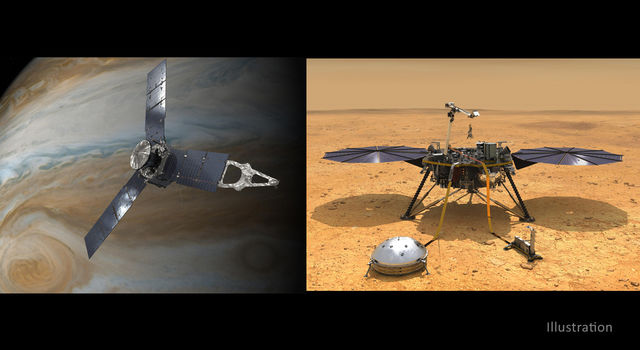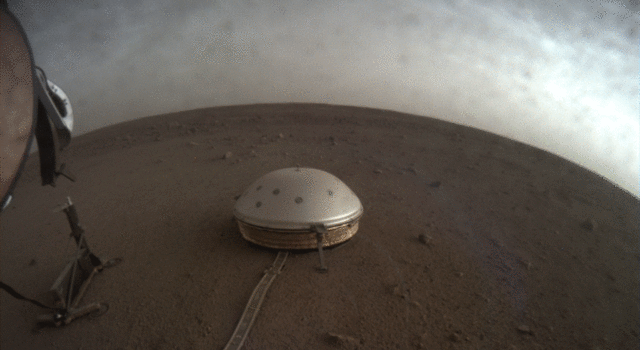Blogs | Dawn Journal | May 31, 2012
Dawn Goes Over 'n' Out
Dear Readers of all Dawnominations,
Far from Earth, on the opposite side of the sun, deep in the asteroid belt, Dawn is gradually spiraling around the giant protoplanet Vesta. Under the gentle pressure of its uniquely efficient ion propulsion system, the explorer is scaling the gravitational mountain from its low-altitude mapping orbit (LAMO) to its second high-altitude mapping orbit (HAMO2).
Dawn spent nearly five months in LAMO, circling the rocky world at an average altitude of 210 kilometers (130 miles) as it acquired a fabulous bounty of pictures; visible, infrared, neutron, and gamma ray spectra; and measurements of the gravity field. As we saw last month, the probe was far more productive in each investigation than the ambitious team members had expected or had ever dared hope it would be. With that outstanding success behind it, it is looking ahead and up to its work in HAMO2, about 680 kilometers (420 miles) high.
Dawn is the first spacecraft to explore Vesta, the second most massive resident of the main asteroid belt between Mars and Jupiter. Indeed, this is the only craft ever to orbit a body in the asteroid belt. No other missions are currently on the books to visit this remote, exotic world, which is now appreciated to be more closely related to the terrestrial planets (including Earth) than to typical asteroids. And now Dawn is receding from it. On May 1, it began the slow ascent to its next observation orbit. It may well be decades before another robotic ambassador from Earth comes as close to Vesta as this bold traveler has.
Humankind's first exploration of Vesta has been exceptionally rewarding. A simple measure of that can be seen with just two photographs. More than two centuries after its discovery, this giant asteroid was first glimpsed by the approaching spaceship from Earth on May 3, 2011. From a distance of 1.2 million kilometers (750 thousand miles), or more than three times the separation between Earth and the moon, Dawn's mapping camera perceived Vesta as only five pixels across. Each pixel spanned more than 110 kilometers (70 miles), revealing nothing new compared to what astronomers' most powerful telescopes had shown (but the image was of importance for navigation purposes). Nevertheless, at the time, it was tremendously exciting to obtain the first views of a distant, unfamiliar shore after a voyage of more than 2.6 billion kilometers (1.6 billion miles) on the interplanetary ocean. Sighting our first celestial port of call more than three and a half years after this cosmic adventure began was thrilling indeed. But now, with more than 25 thousand spectacular photos in hand from much smaller distances, it is even more gratifying to acknowledge that first picture as one of the worst ever taken of Vesta. The Image of the Day from one year later was acquired in October 2011 from 1,700 times closer; and most of the images have been obtained from LAMO, about 5,700 times nearer than that first one. Dawn has rapidly transformed Vesta from a mere fleck among the stars into a fascinating, complex and splendidly detailed world.
Keeping the remote vessel on the planned spiraling course from one mapping orbit to another presents the crew with a set of formidable challenges, but this team has accomplished the maneuvers to successively reach survey orbit, the first high-altitude mapping orbit (HAMO1) and LAMO. The current orbital transfer is complex and demanding, but it is proceeding very well. Controllers update the flight profile every few days to ensure the probe stays close to the carefully designed trajectory to HAMO2. To gain a sense of the progress, go here for your correspondent's atypically succinct weekly summaries of the spiral status.
Imagine a globe of Vesta 30 centimeters (1 foot) in diameter. For the purpose of this illustration, you may be confident that no inhabitants (permanent or temporary) of the massive orb will object if we pretend that it does not rotate. We will use this to demonstrate the alignments of the orbits.
First, let's chose the position of the sun, because the orbits were chosen on the basis of their angles relative to its location. Even in this miniaturized cosmos, the sun today is 213 kilometers (134 miles) away. (Space is big!) What matters more, however, is the direction, so we will place the luminous master of the solar system over (albeit very, very far over) the prime meridian, the 0 degree longitude line on our stationary Vesta. Now we recall that Vesta, like Earth, has seasons because its axis is tipped. It is southern hemisphere summer there, so the sun is not over the equator; rather, it is currently at about 8 degrees south latitude. (On Nov. 29, 2011, when we last used the analogy of the globe, the sun was at 25 degrees south latitude. Since then, it has moved north because of the progression of seasons.) Although Earth's location is not pertinent to this discussion, we can accurately position it 285 kilometers (180 miles) away, high above a point at 5 degrees south latitude and 10 degrees east longitude.
Now with the sun over the 0 degree longitude line, we can orient Dawn's orbits. Think of each orbit as a ring encircling Vesta, going over both poles and crossing the equator at a right angle. Globes of Earth often are supported within a ring like that, and it may be helpful to have a terrestrial globe in mind, or even in sight, as you ponder the celestial arrangement. Because our imaginary Vesta is not rotating, a ring that is aligned with a longitude line represents one of Dawn's orbits. (Of course, Vesta really does rotate, so as the spacecraft loops from pole to pole and back and the protoplanet turns beneath it, all parts come within view of its sensors.)
Survey orbit is a little more than 1.5 meters (5 feet) above the 15 degree west longitude line (and, to make a complete circle, it goes over the 165 degree east longitude line as well). It was from that vantage that the first thorough mapping was conducted in August. The ring representing HAMO1 is twisted to 30 degrees west (and 150 degrees east on the other side of the globe), only about 38 centimeters (15 inches) over the surface. The lower altitude of HAMO1 afforded much better views of the great variety of geological features than the reconnaissance from survey orbit. In addition, because the orbit was shifted farther from the sun, the angle of light on the landscape beneath the spacecraft was different, aiding in formulating a more complete portrait of the terrain. LAMO is rotated still farther from the sun, at 46 degrees west (and 134 degrees east), and is less than 12 centimeters (only 4.7 inches) high. The adventurer spent more time in this low orbit than anywhere else at Vesta.
Now the ship is on its way to HAMO2, which will be at exactly the same altitude as HAMO1 but not the same orientation. When its scientific scrutiny resumes on June 15, the orbit will be approximately aligned with the 35 degree west (and 145 degree east) longitude line on our globe. There is another important difference however. The HAMO2 ring does not quite extend to the poles this time; rather, it is tilted a little so that it goes only to 86 degrees north and south latitude. (Those familiar with orbital mechanics would describe the orbit as having an inclination of 94 degrees; those unfamiliar with orbital mechanics would not describe it that way. You all know who you are.) This tip allows the spacecraft to take advantage of Vesta's gravity field, which navigators have mapped with great accuracy, to gradually turn the orbit by about one degree every five days. As a consequence, by the time Dawn completes its observations in late July, the orbit will be above 27 degrees west (and 153 degrees east).
Using different orientations of the orbits relative to the sun is a crucial element of the strategy for gathering such a wealth of scientifically valuable data on Vesta. Each orbit provides views of the ground with different illumination angles.
In LAMO, the lighting was less important, as the primary objectives of that phase were to measure the protoplanet's nuclear radiation and changing gravitational tug as Dawn circled it, and neither of those depended on sunlight. (Although it was purely bonus, the operations team still managed to photograph most of the surface at high resolution.) But the LAMO angle was chosen in large part to ensure that the desired plane for HAMO2 would be within reach when the time came to undertake the orbital ascent. Moving the plane of an orbit is energetically very very expensive, and even with Dawn's extraordinary capabilities, only limited changes are practicable.
In contemplating the Vesta-centric universe we have just described, it may be evident that Dawn is not only enlarging its orbit from LAMO to HAMO2 but also twisting and tilting it. As with the descent to LAMO, described in more detail here, the team has designed a flight profile that relies principally on the extraordinary capability of ion propulsion but also rides Vesta's gravitational currents to help accomplish some of the shifts in the orbit plane.
The location of the sun described above suggests why HAMO2 is valuable. Orbiting farther from the sun than Earth, Vesta's year is equivalent to more than 3.6 terrestrial years. The seasons pass correspondingly slowly, lasting an average of 11 months each. In the time that will have passed from HAMO1 in October 2011 to HAMO2 in June and July, the sun will have moved northward, thus revealing some terrain that was in the deep shadow of northern winter during HAMO1. It is that landscape that is the principal target of HAMO2. As we will see in the next log, however, this phase will present opportunities for other investigations as well.
HAMO2 will be the final intensive campaign of observing Vesta. When it is complete, the craft will once again resume powered flight. It will escape from Vesta's gravitational grip in August and begin the next stage of its interplanetary voyage, aiming for dwarf planet Ceres in 2015 -- a new world explored, another world awaits!
Dawn is 610 kilometers (380 miles) from Vesta. It is also 3.37 AU (503 million kilometers or 313 million miles) from Earth, or 1,385 times as far as the moon and 3.32 times as far as the sun today. Radio signals, traveling at the universal limit of the speed of light, take 56 minutes to make the round trip.
Dr. Marc D. Rayman
10:30 p.m. PDT May 31, 2012
TAGS:DAWN, VESTA, CERES, DWARF PLANETS, SOLAR SYSTEM, MISSION, SPACECRAFT







